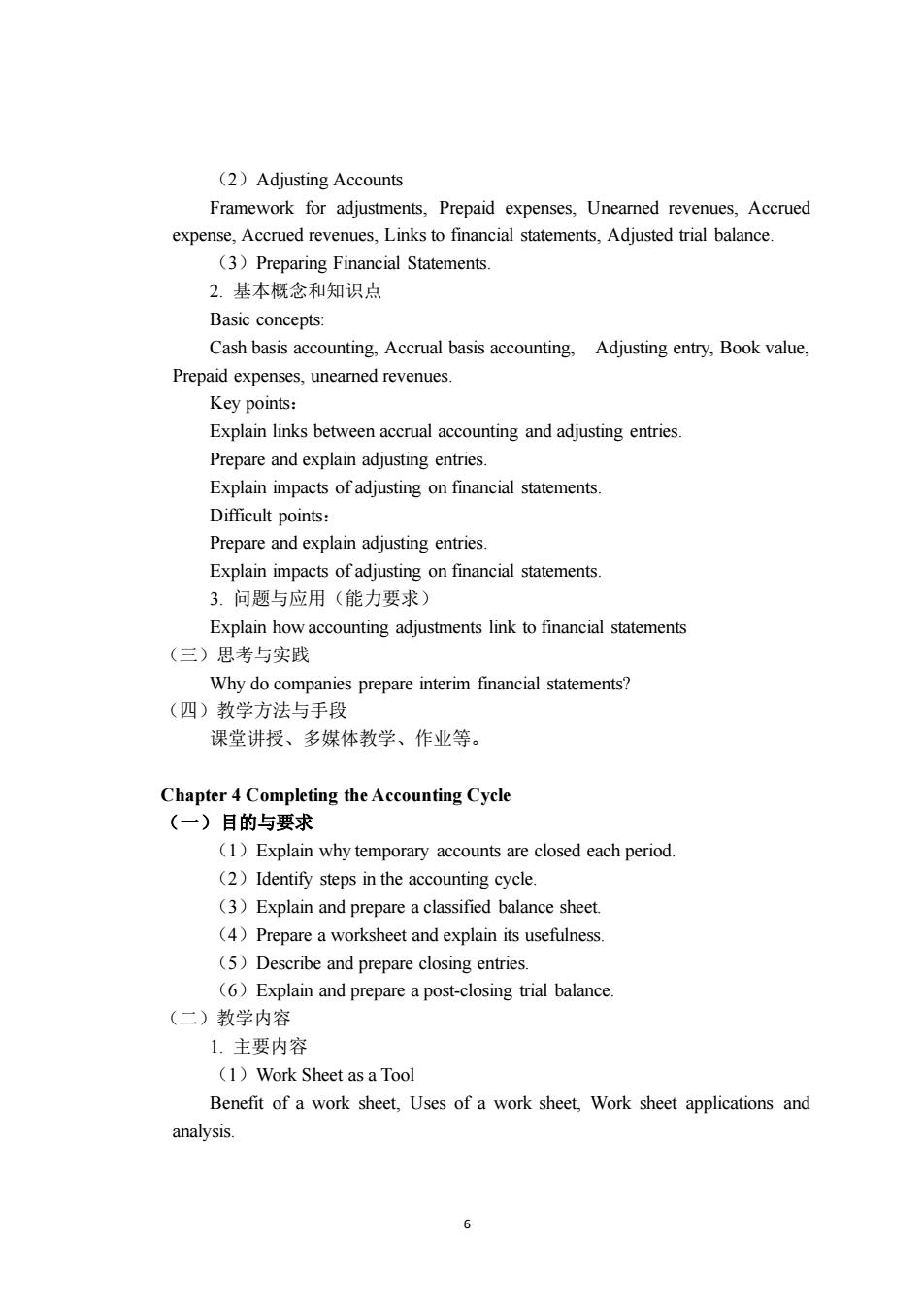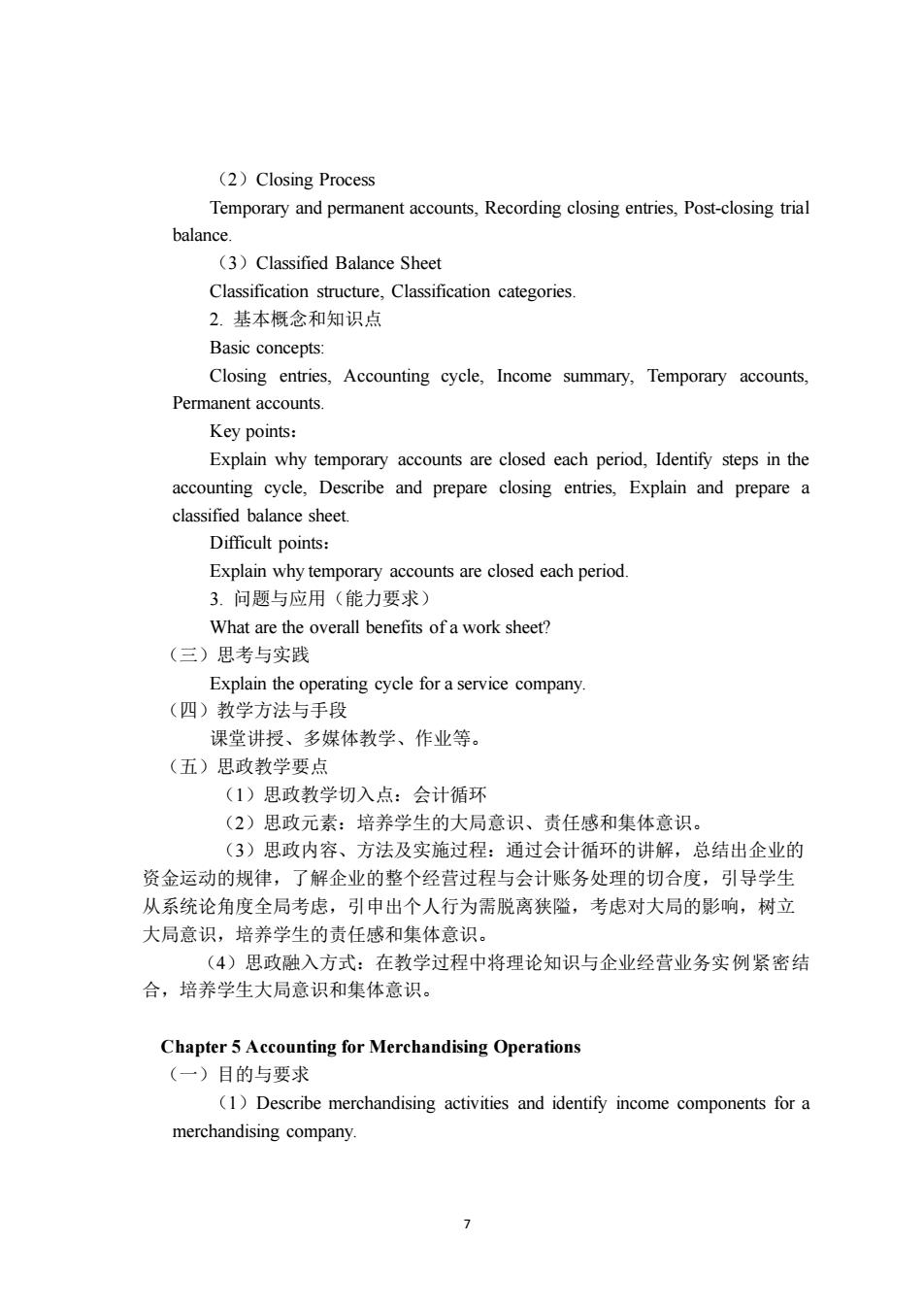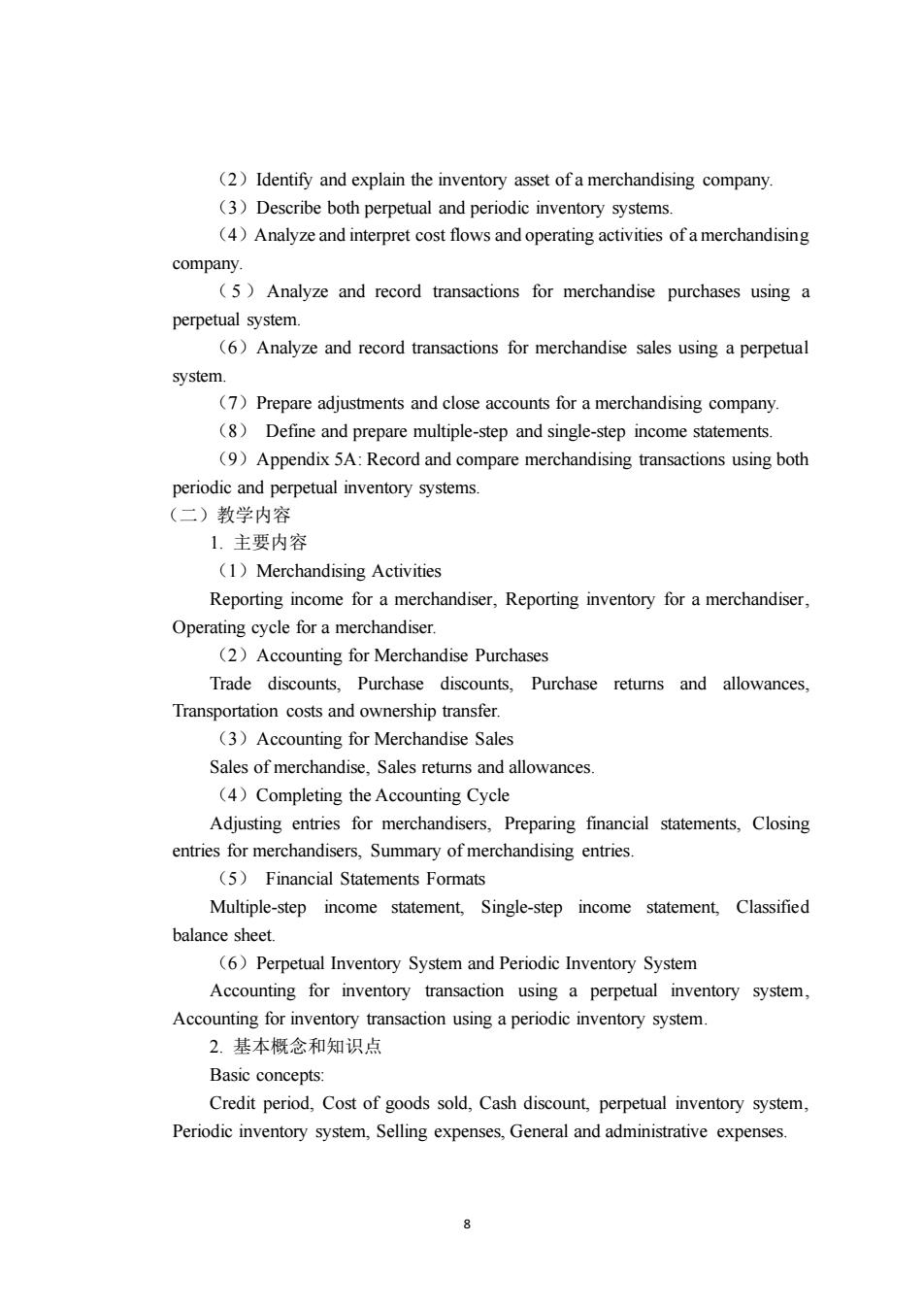
(2)Adjusting Accounts Framework for adjustments,Prepaid expenses,Unearned revenues,Accrued expense,Accrued revenues,Links to financial statements,Adjusted trial balance. (3)Preparing Financial Statements. 2.基本概念和知识点 Basic concepts: Cash basis accounting.Accrual basis accounting.Adjusting entry.Book value Prepaid expenses,unearned revenues. Key points: Explain links between accrual accounting and adjusting entries Prepare and explain adjusting entries. Explain impacts of adjusting on financial statements Difficult points: Prepare and explain adjusting entries. Explain impacts of adjusting on financial statements 3.问题与应用(能力要求) Explain how accounting adjustments link to financial statement (三)思考与实践 Why do companies prepare interim financial statements? (四)教学方法与手段 课堂讲授、多媒体教学、作业等 Chapter 4 Completing the Accounting Cycle (一)目的与要求 (1)Explain why temporary accounts are closed each period (2)Identify steps in the accounting cycle. (3)Explain and prepare aclassified balance sheet. (4)Prepare a worksheet and explain its usefulness. (5)Describe and prepare closing entries. (6)Explain and prepare a post-closing trial balance (二)教学内容 1.主要内容 (1)Work Sheet as a Tool Benefit of a work sheet,Uses of a work sheet,Work sheet applications and analysis
6 (2)Adjusting Accounts Framework for adjustments, Prepaid expenses, Unearned revenues, Accrued expense, Accrued revenues, Links to financial statements, Adjusted trial balance. (3)Preparing Financial Statements. 2. 基本概念和知识点 Basic concepts: Cash basis accounting, Accrual basis accounting, Adjusting entry, Book value, Prepaid expenses, unearned revenues. Key points: Explain links between accrual accounting and adjusting entries. Prepare and explain adjusting entries. Explain impacts of adjusting on financial statements. Difficult points: Prepare and explain adjusting entries. Explain impacts of adjusting on financial statements. 3. 问题与应用(能力要求) Explain how accounting adjustments link to financial statements (三)思考与实践 Why do companies prepare interim financial statements? (四)教学方法与手段 课堂讲授、多媒体教学、作业等。 Chapter 4 Completing the Accounting Cycle (一)目的与要求 (1)Explain why temporary accounts are closed each period. (2)Identify steps in the accounting cycle. (3)Explain and prepare a classified balance sheet. (4)Prepare a worksheet and explain its usefulness. (5)Describe and prepare closing entries. (6)Explain and prepare a post-closing trial balance. (二)教学内容 1. 主要内容 (1)Work Sheet as a Tool Benefit of a work sheet, Uses of a work sheet, Work sheet applications and analysis

(2)Closing Process Temporary and permanent accounts,Recording closing entries,Post-closing trial balance. (3)Classified Balance Sheet Classification structure,Classification categories. 2.基本概念和知识点 Basic concepts: Closing entries.Accounting cycle.Income summary.Temporary accounts. Permanent accounts Key points: Explain why temporary accounts are closed each period,Identify steps in the accounting cycle,Describe and prepare closing entries,Explain and prepare a classified balance sheet Difficult points: Explain why temporary re dach period 3.问题与应用(能力要求) What are the overall benefits of a work sheet? (三)思考与实践 Explain the operating cycle for a service company (四)教学方法与手段 课堂讲授、多媒体教学、作业等。 (五)思政教学要点 (1)思政教学切入点:会计循环 (2)思政元素:培养学生的大局意识、责任感和集体意识。 (3)思政内容、方法及实施过程:通过会计循环的讲解,总结出企业的 资金运动的规律,了解企业的整个经营过程与会计账务处理的切合度,引导学生 从系统论角度全局考虑,引申出个人行为需脱离狭隘,考虑对大局的影响,树立 大局意识,培亲学生的责任感和集体意识。 (4)思政融入方式:在教学过程中将理论知识与企业经营业务实例紧密结 合,培养学生大局意识和集体意识。 Chapter 5 Accounting for Merchandising Operations (一)目的与要求 (1)Describe merchandising activities and identify income components for a merchandising company. 7
7 (2)Closing Process Temporary and permanent accounts, Recording closing entries, Post-closing trial balance. (3)Classified Balance Sheet Classification structure, Classification categories. 2. 基本概念和知识点 Basic concepts: Closing entries, Accounting cycle, Income summary, Temporary accounts, Permanent accounts. Key points: Explain why temporary accounts are closed each period, Identify steps in the accounting cycle, Describe and prepare closing entries, Explain and prepare a classified balance sheet. Difficult points: Explain why temporary accounts are closed each period. 3. 问题与应用(能力要求) What are the overall benefits of a work sheet? (三)思考与实践 Explain the operating cycle for a service company. (四)教学方法与手段 课堂讲授、多媒体教学、作业等。 (五)思政教学要点 (1)思政教学切入点:会计循环 (2)思政元素:培养学生的大局意识、责任感和集体意识。 (3)思政内容、方法及实施过程:通过会计循环的讲解,总结出企业的 资金运动的规律,了解企业的整个经营过程与会计账务处理的切合度,引导学生 从系统论角度全局考虑,引申出个人行为需脱离狭隘,考虑对大局的影响,树立 大局意识,培养学生的责任感和集体意识。 (4)思政融入方式:在教学过程中将理论知识与企业经营业务实例紧密结 合,培养学生大局意识和集体意识。 Chapter 5 Accounting for Merchandising Operations (一)目的与要求 (1)Describe merchandising activities and identify income components for a merchandising company

(2)Identify and explain the inventory asset of a merchandising company (3)Describe both perpetual and periodic inventory systems. (4)Analyze and interpret cost flows and operating activities ofa merchandising company. (5)Analyze and record transactions for merchandise purchases using a perpetual system. (6)Analyze and record transactions for merchandise sales using a perpetual system. (7)Prepare adjustments and close accounts for a merchandising company (8)Define and prepare multiple-step and single-step income statements. (9Appendix 5A:Record and compare merchandising transactions using both periodic and perpetual inventory systems. (二)教学内容 1.主要内容 (1)Merchandising Activities Reporting income for a merchandiser,Reporting inventory for a merchandiser, Operating cycle for a merchandiser. (2)Accounting for Merchandise Purchases Trade discounts,Purchase discounts,Purchase returns and allowances, Transportation costs and ownership transfer. (3)Accounting for Merchandise Sales Sales of merchandise.Sales returns and allowances. (4)Completing the Accounting Cycle Adjusting entries for merchandisers.Preparing financial statements,Closing entries for merchandisers,Summary of merchandising entries. (5)Financial Statements Formats Multiple-step income statement,Single-step income statement,Classified halance sheet (6)Perpetual Inventory System and Periodic Inventory System Accounting for inventory transaction using a perpetual inventory system. Accounting for inventory transaction using a periodic inventory system. 2.基本概念和知识点 Basic concepts Credit period.Cost of goods sold,Cash discount perpetual inventory system Periodic inventory system,Selling expenses,General and administrative expenses. 8
8 (2)Identify and explain the inventory asset of a merchandising company. (3)Describe both perpetual and periodic inventory systems. (4)Analyze and interpret cost flows and operating activities of a merchandising company. ( 5 ) Analyze and record transactions for merchandise purchases using a perpetual system. (6)Analyze and record transactions for merchandise sales using a perpetual system. (7)Prepare adjustments and close accounts for a merchandising company. (8) Define and prepare multiple-step and single-step income statements. (9)Appendix 5A: Record and compare merchandising transactions using both periodic and perpetual inventory systems. (二)教学内容 1. 主要内容 (1)Merchandising Activities Reporting income for a merchandiser, Reporting inventory for a merchandiser, Operating cycle for a merchandiser. (2)Accounting for Merchandise Purchases Trade discounts, Purchase discounts, Purchase returns and allowances, Transportation costs and ownership transfer. (3)Accounting for Merchandise Sales Sales of merchandise, Sales returns and allowances. (4)Completing the Accounting Cycle Adjusting entries for merchandisers, Preparing financial statements, Closing entries for merchandisers, Summary of merchandising entries. (5) Financial Statements Formats Multiple-step income statement, Single-step income statement, Classified balance sheet. (6)Perpetual Inventory System and Periodic Inventory System Accounting for inventory transaction using a perpetual inventory system, Accounting for inventory transaction using a periodic inventory system. 2. 基本概念和知识点 Basic concepts: Credit period, Cost of goods sold, Cash discount, perpetual inventory system, Periodic inventory system, Selling expenses, General and administrative expenses